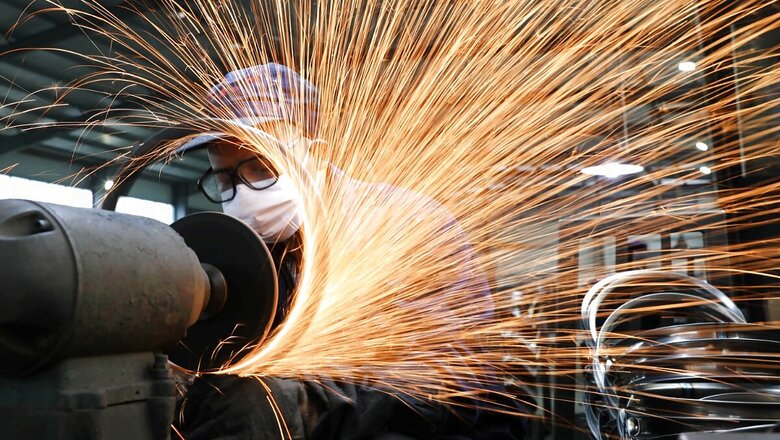
views
The Central Hall of Parliament broke into rapturous applause. It was November 8, 2010. All eyes were riveted on a hypnotic orator and a charismatic personality. In “Asia and around the world, India is not simply emerging; India has already emerged”, said President Obama! The sweet melody resonated in Indian ears for days!
Has India indeed emerged? The answer is both yes and no. India’s GDP soared to $1,676 billion in 2010 from $468 billion in 2000 and grew further to $2,869 billion in 2019 (World Bank figures). However, with a nominal per capita GDP of around $2,000, India trails at 148th position out of 193 economies. Yet many other economic parameters – including fiscal deficit, inflation, foreign exchange reserves and foreign direct investment (FDI) – are healthy.
Thus, the big question remains whether we are close to reaching our potential. Truth be told, we still have a long way to go. We have enviable strengths as also pronounced fault lines. India is like a jumbo that has been taxiing on the runway for some two decades but has been bashful of revving up the engines full throttle, to take off. We progress towards the goal but are unable, at times, to overcome the eleventh-hour jitters.
Take India’s defence requirements, for example. Her security environment is complicated, yet due to limited domestic capacity, she needs to import defence platforms. In 2005 the Indian Navy flagged a requirement for minesweepers. The negotiations spanned several years with South Korea’s Kangnam Corporation to procure/build 12 vessels. We eventually cancelled the $5 billion deal in 2018. Our navy is still without minesweepers and we are now contemplating leasing them from Korea. The reason? Overcaution, suspicion and fear of criticism. Unfortunately, this is not a one-off occurrence.
Delivering the Nani Palkhivala Memorial Lecture last year, Tata Sons chairman N Chandrasekaran hit the bullseye in noting, “There is a massive risk aversion within the system, which has led to an ‘undesirable equilibrium’ where it is safer to avoid or delay decisions.” Alas, hardly any official has ever been sacked in India for not making a decision, regardless of the cost to the nation.
Let me next turn to external economic cooperation which, in this era of globalisation, serves as the springboard for rapid GDP growth. “Throughout history, India has been most successful and prosperous when it was most connected to the rest of the world,” opines former foreign secretary Shivshankar Menon.
Indeed China, the Asian Tigers and Tiger Cubs, all owe their prosperity to globalisation, economic reforms, tariff reduction, exports and becoming a part of regional/global supply chains. They have further secured their markets by aggressively concluding preferential trading arrangements such as FTA (Free Trade Agreement) and CEPA (Comprehensive Economic Partnership Agreement).
After 1991, India too initiated economic reforms and gingerly embarked upon a similar path with noticeable success. India’s trade to GDP ratio which stood at 13% in 1990, improved to almost 22% by 2000, jumped to more than 40% by 2010 and has since plateaued around the said mark. That is because India needs a string of ambitious FTAs with key partners and to carve out a bigger niche for itself in regional/global supply chains, which is still a work in progress.
In November 2019, after seven years of negotiations on RCEP (Regional Comprehensive Economic Partnership) with 15 Asia-Pacific nations, India pulled out, and rightly so, due to economic, security and geopolitical issues with China. There is no reason whatsoever for India to allow free access to her market, to a command economy and adversarial nation like China, which subsidises its industry, erects non-tariff barriers against Indian exports and runs a huge trade surplus, year after year.
But what about other nations? To be candid, India’s track record is nothing much to write home about. There has been little progress in FTA talks with key partners including Australia, Canada and the European Union. We are engaged in mutual finger-pointing with the US over a limited trade deal. Our promise to upgrade CEPA with South Korea has made little headway notwithstanding several summit-level commitments.
India and the EU commenced FTA talks in 2007 that were adjourned in 2013. “The EU side had laid down certain pre-conditions for resuming FTA negotiations and much effort had to be made to convince the EU bureaucracy,” wrote Ambassador Sibal recently, which is disquieting. We have a robust trade relationship, which has the potential of growing exponentially, as the Indian economy heads towards the $10-trillion mark. Yet the EU acted tough, which carries a message. Prospective partners see India as an attractive business proposition but are not bereft of choices, and are willing to invest only a finite amount of political capital and energy to engage us.
The website of our department of commerce notes – “India is a late, and cautious, starter in concluding comprehensive preferential tariff agreements”. Adds India’s commerce and industry minister (October 31, 2019) – “India will no more sign any FTA in a rush…we will be a part of the world’s international trading but will not compromise national interest or interests of industry”.
That is absolutely in order. No country will or can compromise its national interests. Yet we need to ask ourselves a question. Why is it that only India has so many constraints in finalising an FTA? Is it because we are the most unique country in the world?
We maintain that earlier FTAs did not serve us well and that the trade deficit has been increasing. The reality is different. We have a narrow industrial base and a limited basket of exportable goods and services that we are competitive in. Our demand for consumer goods is growing. Thus, we have only two choices. Expand our manufacturing base or import. Secondly, the scope of our FTAs is not as broad as it should be and, therefore, the utilisation levels remain low.
What constitutes rush? We launched CEPA negotiations with Canada in 2010 that are in no way near closure. We have been in talks over an FTA with New Zealand since April 2010 and since May 2011 with Australia.
It is time for some serious introspection. It is well known that barring honourable exceptions, Indian industry is competition-shy and content with serving the sizeable domestic market. Secondly, in a large and diverse country like India, there is bound to be opposition to any major decision, from one quarter or the other. Every stakeholder will naturally try to protect his or her narrow interests. Only the government has the full picture and can take a holistic view.
The Indian jumbo needs to rev up its engines, with a determined push, to get airborne. Both at home and abroad the proverbial ‘last-mile gap’ needs to be bridged, and bridged quickly. For, as they say, time and tide wait for no man!
Read all the Latest News, Breaking News and Coronavirus News here. Follow us on Facebook, Twitter and Telegram.

















Comments
0 comment